Telecom API Market Size
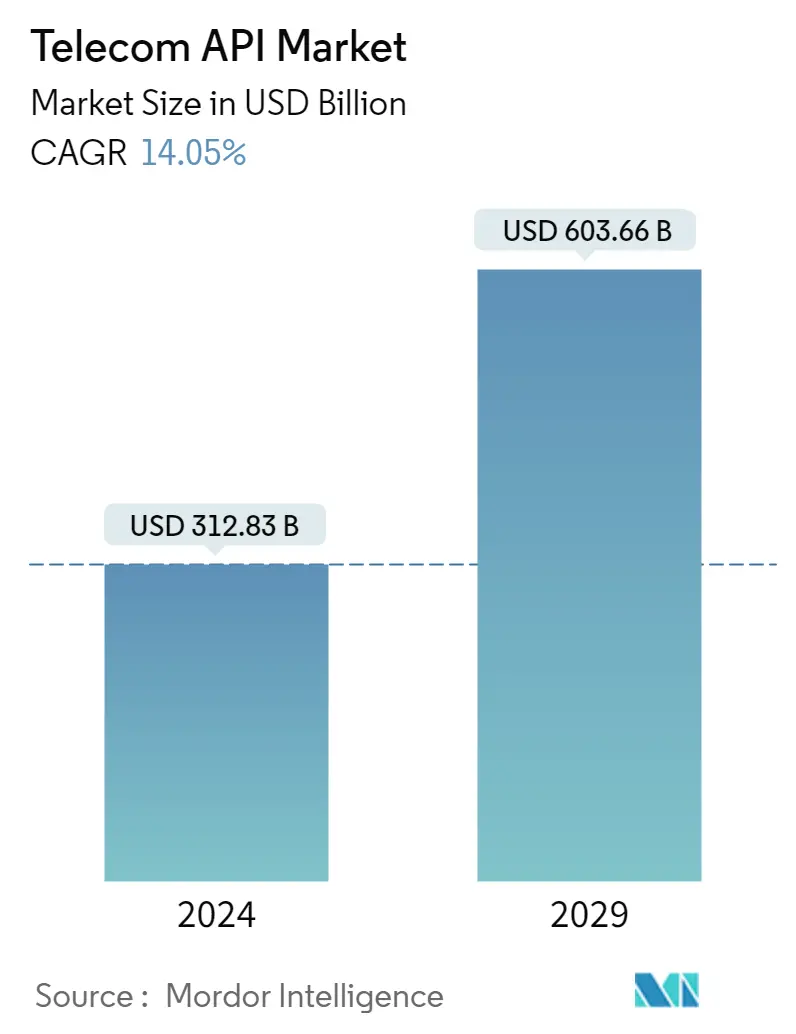
| Study Period | 2019 - 2029 |
| Market Size (2024) | USD 312.83 Billion |
| Market Size (2029) | USD 603.66 Billion |
| CAGR (2024 - 2029) | 14.05 % |
| Fastest Growing Market | Asia Pacific |
| Largest Market | North America |
Major Players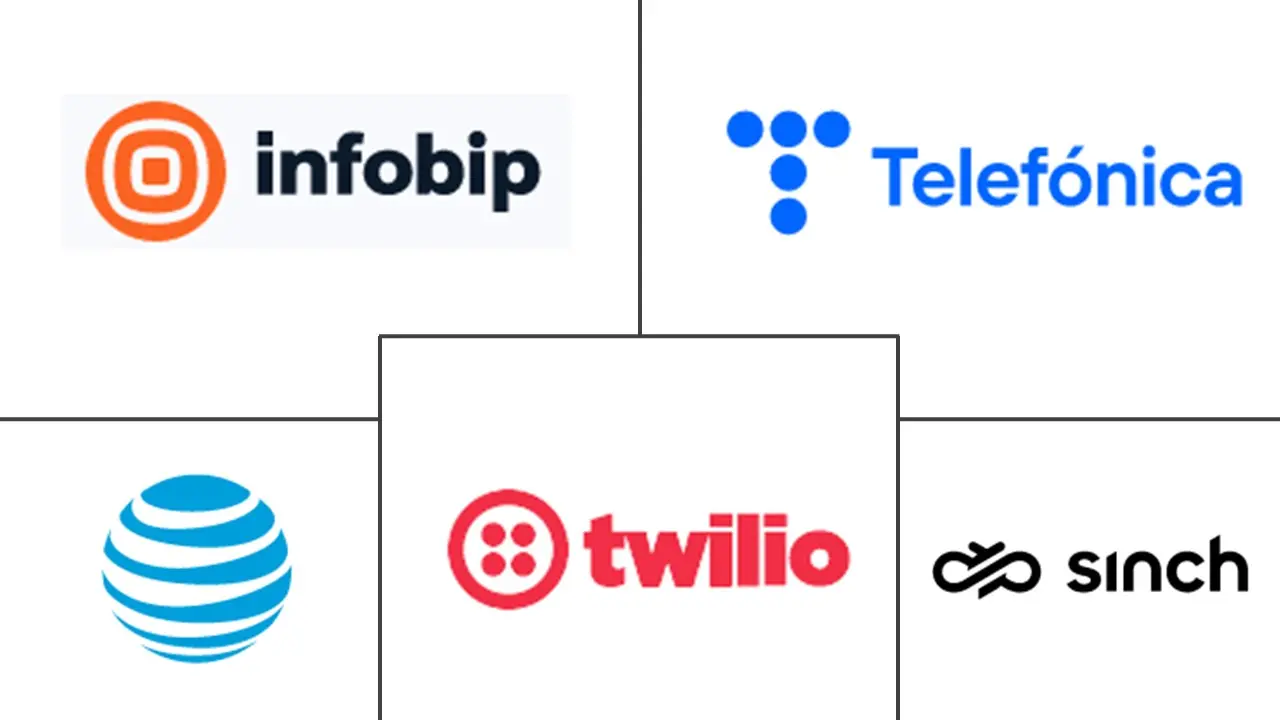
*Disclaimer: Major Players sorted in no particular order |
Need a report that reflects how COVID-19 has impacted this market and its growth?
Telecom API Market Analysis
The Telecom API Market size is estimated at USD 312.83 billion in 2024, and is expected to reach USD 603.66 billion by 2029, growing at a CAGR of 14.05% during the forecast period (2024-2029).
A telecom API (application programming interface) is a set of protocols, tools, and definitions that allow different software applications to communicate and interact with telecom network services, such as voice calling, messaging, location services, and payment processing. Further, the proliferation of smartphones and the increasing popularity of mobile apps created a significant demand for telecom APIs, often used to enhance app functionality. According to Ericsson, smartphone mobile network subscriptions worldwide reached almost 6.7 billion in 2023, and they are expected to exceed 7.7 billion by 2028.
- Telecom companies are undergoing digital transformation to stay competitive. APIs enable integration between different systems and facilitate new digital services. Telecom operators are leveraging APIs not only for service delivery but also for generating additional revenue streams through API monetization models such as revenue sharing and subscription-based pricing.
- For instance, in May 2024, Digital Nasional Berhad (DNB) and Ericsson announced a program to catalyze the digitalization of enterprises in Malaysia, enabled by the capabilities of the world-leading 5G network. These pioneer industry initiatives will pave the way for advanced technologies to enable the digitalization of enterprises across different industry verticals and drive Malaysia forward as a leading digital nation.
- The proliferation of IoT devices requires seamless connectivity and communication between devices and backend systems. Telecom APIs provide the necessary interfaces for device management, data exchange, and control, supporting the growth of the IoT ecosystem. According to IHS, more than 75 billion Internet of Things (IoT) connected devices will be in use by 2025.
- The recent increase in the number of startups launched in the field of telecom API in markets such as Asia-Pacific and Africa is anticipated to open unique opportunities for telecom API service providers during the forecast year. Industry giants such as Vodafone, Google, and communications service providers (CSPs) and technology supplier groups have created partnerships with startups from these emerging markets to complete a nurturing ecosystem for the growth of telecom startups by offering their APIs for application developments, thus propelling the market’s growth. For instance, in November 2023, major players like Twilio and Nexmo integrated AI into their APIs, making them more innovative and efficient for automating tasks and personalizing communications.
- Moreover, compatibility issues with existing legacy systems obstruct the seamless integration of APIs. The integration of APIs faces considerable challenges due to compatibility issues with legacy systems. These hurdles stem from the significant differences between the architecture and technology of older legacy systems and the requirements of modern APIs. Often, legacy systems need more flexibility, standards compliance, and adaptability to connect with newer APIs seamlessly. These challenges include technological disparities, data formats, security protocols, and scalability between legacy systems and modern API standards. Addressing these challenges is critical to harness the potential of modern APIs within existing systems.
- At the time of the COVID-19 pandemic, telecom API vendors developed solutions to cope with the situation for better accessibility by implementing strategies such as new product developments, mergers and acquisitions, and geographical expansion. For instance, in March of the previous year, US-based T-Mobile Venture invested in telecom API development startup Signalwire, which develops voice, video, and messaging APIs to advance API and 5G technology, among others.
- In addition, the Russia-Ukraine War disrupted infrastructure and internet connectivity in the region, leading to service interruptions for telecom API providers and their customers. Such geopolitical tensions may result in regulatory changes or sanctions affecting cross-border business operations, potentially complicating partnerships and transactions in the telecom API market.
Telecom API Market Trends
Hybrid Segment to Hold Considerable Market Shares
- Hybrid deployment in the context of telecom APIs refers to a model that combines on-premises infrastructure and cloud services. This strategy allows telecom companies to maintain control over critical systems and data while leveraging the flexibility and scalability of the cloud. Telecom companies often opt for a hybrid approach to comply with regulatory requirements while benefiting from cloud efficiencies. For instance, in April 2023, Google Cloud introduced Anthos Service Mesh, built on Apigee technology, for managing and securing API traffic in hybrid environments.
- The telecommunications sector is significantly transitioning from physical to digital networks. The telecom industry comprises a wide range of consumers who need to be offered a broad spectrum of services, irrespective of their appliances and locations. To cater to this, telecom carriers seek cloud solutions to deliver their services in response to consumer demands.
- This rise in demand for microservices can be considered a sign of the natural evolution of enterprise application development. Technology trends, such as migration to cloud platforms and shifting toward an API economy, are witnessed in the current market scenario. Web-based applications can help service providers in the telecom industry improve the quality and reliability of their mobile communications, broadband services, and open-source technologies, boost their market share, and improve their profitability.
- Focusing on improving the customer experience, telecommunications players are revising microservices architecture (MSA) in their IT and network architectural capabilities to support extensibility and elasticity. The supportive government regulations worldwide encourage telecom players to open their communication systems via APIs. This is expected to promote the growth of middleware architecture solutions across telecommunications business models.
- The Mobile Application Support Environment (MASE) is a distributed system that works on mobile devices and devices known as mobility gateways. The latter act as a bridge between fixed and wireless network infrastructures. It is an agent for mobile clients, often linked over unreliable wireless access networks with limited bandwidth. MASE gives access to the UMTS adaption layer (UAL), which allows unified access to all conceivable underlying networks for applications and middleware components. An additional general support layer provides the functionality required for distributed systems.
- The evolution of cellular network technology has authorized users to experience faster data speeds and lower latency. It has also prompted the rapidly increasing use of data-heavy services and applications. The significant rise in the volume of data carried by cellular networks has been primarily driven by consumer need for video and business and consumer moves to cloud services. This factor is expected to drive the need for a 5G connection that offers fast and high-capacity networks. Moreover, with the introduction of 5G in the coming years, telecom companies are expected to be eager to focus on edge computing solutions, which would be enabled by middleware architecture vendors. According to the Ericsson Mobility Report released in November 2023, 5G mobile subscriptions were anticipated to exceed 5.3 billion by the end of 2029.
- Various players are investing in hybrid solutions as they offer a flexible approach, allowing telecom companies to blend the benefits of on-premises and cloud-based solutions. This also enables them to meet varying compliance requirements, security concerns, and scalability needs. For instance, in February 2024, NTT DOCOMO INC., Japan's significant mobile operator with more than 89 million subscribers, selected AWS to commercially deploy its nationwide 5G Open Radio Access Network (RAN) in Japan. AWS supports DOCOMO in developing its 5G Core on AWS, which runs in a hybrid cloud environment.
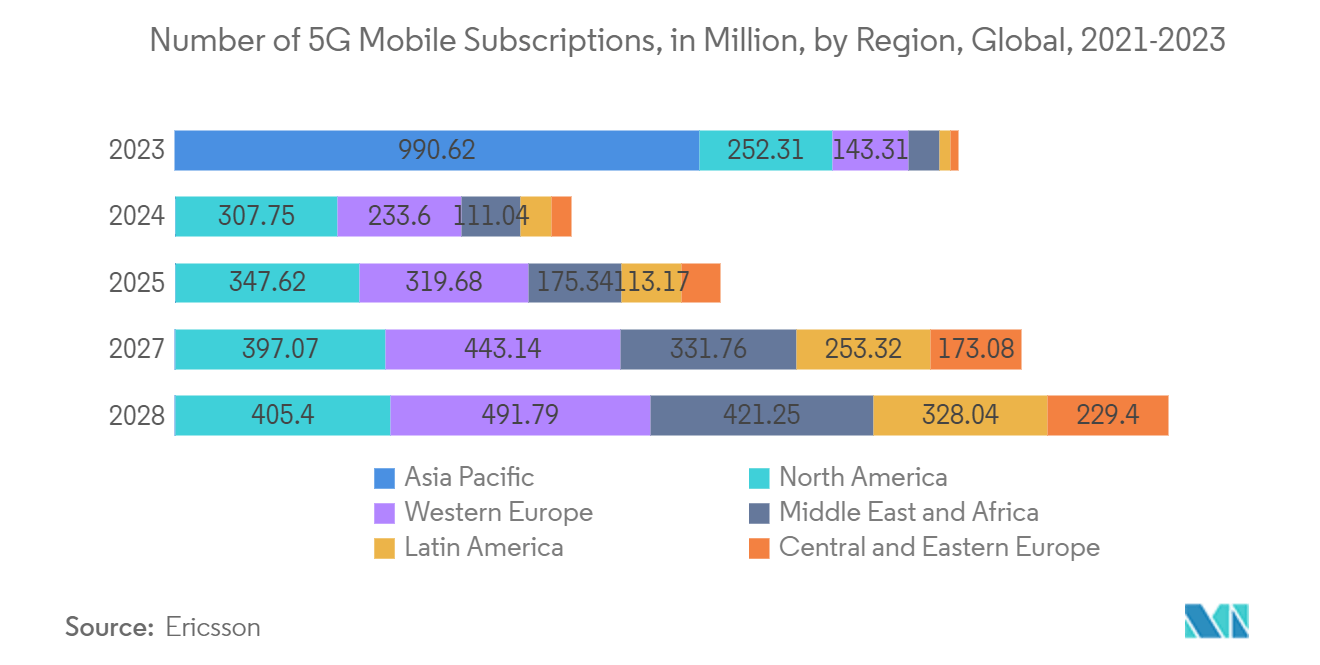
North America to Hold Significant Market Share
- The region is significantly driving market growth mainly due to its early and widespread adoption of API technologies. Rapid technological innovations, along with the increasing penetration of cloud-based services across the telecom sector, are expected to drive the growth of the telecom API market. For instance, in February 2023, telecom operators planned to invest an average of USD 206 million per year for the next three to five years in the technologies required for the telco cloud transformation programs to support their mobile network strategies.
- The region comprises the United States and Canada. A significant number of mobile network operators are already leveraging telecom APIs to sustain robocall detection and unwanted call management in the United States. Some of these same processes and procedures will become bridges toward the mediation of LoT network authentication and authorization. According to the International Telecommunication Union, in 2023, the number of mobile subscriptions in the Americas region totaled over 1.14 billion.
- Recently, to create safe 5G network slicing and enhance Canada's security and defense, the University of Waterloo announced the creation of the "5G and Beyond" mobile network technology collaboration. The organization has received funding from the Department of National Defense (DND) for its Innovation for Defense Excellence and Security (IDEaS) program. A group of computer scientists from the University of Waterloo is leading the multi-partner consortium. It will cost CAD 1.5 million (USD 1.12 million).
- In addition, according to GSMA, in 2023, 5G connections accounted for 34% of all mobile connections in Canada, and they are expected to reach 49% by 2025.
- Furthermore, government initiatives aimed at improving digital connectivity and supporting innovation in telecommunications drive the demand in the market. Funding programs and incentives may encourage the deployment of telecom networks nationwide. In April 2023, Ericsson invested more than CAD 470 million for the next five years jointly with the government of Canada in the research and development (R&D) of next-generation technologies such as artificial intelligence, 5G advanced, 6G, Cloud RAN, and core network.
- With the rising demand for cost-effective and user-friendly browser-based communication solutions, many notable vendors are looking to introduce vertical-specific WebRTC and cloud solutions in the region, which is expected to boost the market's growth.
- Canada's facilities-based telecommunications service providers, the companies that build and operate Canada's telecommunications networks, are focused on ensuring investments in network infrastructure and operations, resulting in incredibly resilient networks in the face of intensified network traffic and altered usage patterns, further propelling the telecom API market.
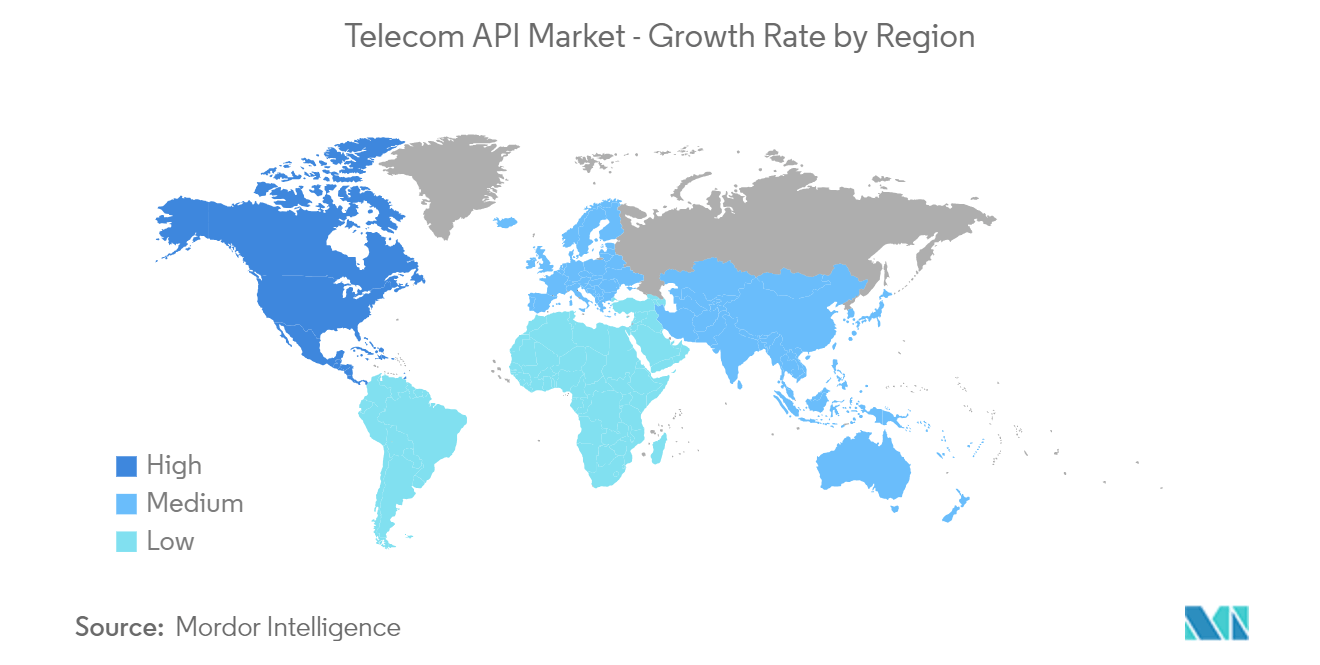
Telecom API Industry Overview
The intensity of competitive rivalry is high in the telecom API market, owing to the presence of major telecom players such as AT&T Inc., Nokia Corporation, Twilio Inc., and Ericsson. The level of intensity of competitive rivalry is expected to increase significantly during the forecast period, owing to higher market penetration and the deployment of powerful, innovative API algorithms, especially by established market players.
- February 2024: Ericsson-owned Vonage and American multinational telecommunications operator AT&T collaborated to expand the power of the network for developers and enterprises through APIs. Vonage’s communications and network APIs make it easy for developers to embed communications capabilities into applications, systems, and workflows.
- September 2023: German carrier Deutsche Telekom announced the commercial launch of network application programming interfaces (APIs) under the brand “MagentaBusiness API.” With this, developers and business customers can now build apps and services that communicate using Deutsche Telekom’s network in Germany.
Telecom API Market Leaders
AT&T Inc.
Telefónica SA
Twilio Inc.
Infobip Ltd
Sinch (CLX Communication)
*Disclaimer: Major Players sorted in no particular order
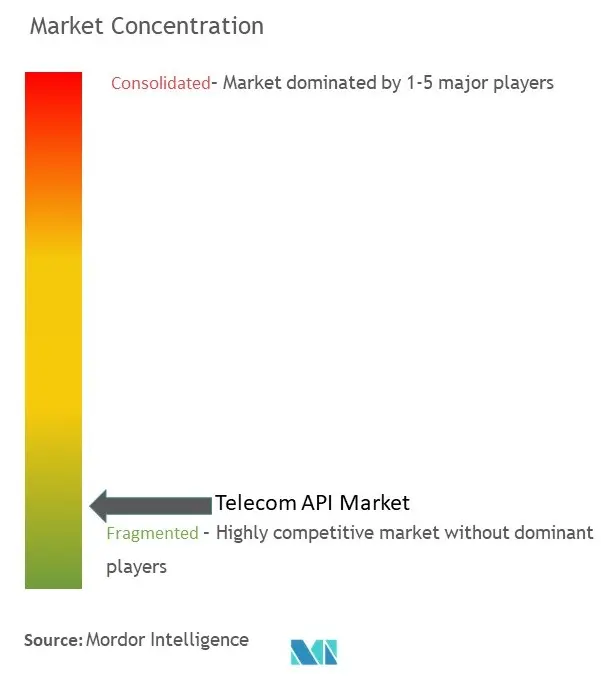
Telecom API Market News
- March 2024: Comviva, a provider of operations support systems (OSS) and business support systems (BSS), contributed to the expansion of application programming interfaces (APIs) driven by 5G, which is likely to help telecom operators monetize their fifth-generation networks.
- February 2024: The GSMA outlined the mobile industry and technology partners' substantial advancement in unlocking the full potential of 5G networks and commercializing network APIs through the GSMA Open Gateway initiative. A year since GSMA Open Gateway was unveiled at MWC 2023, 47 mobile operator groups, representing 239 mobile networks and 65% of connections worldwide, have signed up for the initiative.
Telecom Application Programming Interface (API) Market Report - Table of Contents
1. INTRODUCTION
1.1 Study Assumptions and Market Definition
1.2 Scope of the Study
2. RESEARCH METHODOLOGY
3. EXECUTIVE SUMMARY
4. MARKET INSIGHTS
4.1 Market Overview
4.2 Industry Ecosystem Analysis
4.3 Industry Attractiveness - Porter's Five Forces Analysis
4.3.1 Bargaining Power of Suppliers
4.3.2 Bargaining Power of Buyers
4.3.3 Threat of New Entrants
4.3.4 Intensity of Competitive Rivalry
4.3.5 Threat of Substitute Products
4.4 Impact of Key Macroeconomic Trends on the Market
5. MARKET DYNAMICS
5.1 Market Drivers
5.1.1 Increasing Demand for Mobile Data and the Rise of Digital Communication
5.1.2 Advent of 5G technology
5.2 Market Challenges
5.2.1 Security Concern Due to the Increasing API Vulnerabilities
6. API USE CASES IN THE TELECOM INDUSTRY
7. MARKET SEGMENTATION
7.1 By Type of Service
7.1.1 Messaging API
7.1.2 IVR/Voice Store and Voice Control API
7.1.3 Payment API
7.1.4 WebRTC (Real-Time Connection) API
7.1.5 Location and Map API
7.1.6 Subscriber Identity Management and SSO API
7.1.7 Other Types of Service
7.2 By Deployment Type
7.2.1 Hybrid
7.2.2 Multi-cloud
7.2.3 Other Deployment Types
7.3 By End User
7.3.1 Enterprise Developer
7.3.2 Internal Telecom Developer
7.3.3 Partner Developer
7.3.4 Long Tail Developer
7.4 By Geography
7.4.1 North America
7.4.2 Europe
7.4.3 Asia-Pacific
7.4.3.1 China
7.4.3.2 South Korea
7.4.3.3 Australia
7.4.3.4 New Zealand
7.4.3.5 India
7.4.3.6 Thailand
7.4.3.7 Singapore
7.4.3.8 Malaysia
7.4.3.9 Rest of Asia-Pacific
7.4.4 Latin America
7.4.5 Middle East and Africa
8. COMPETITIVE LANDSCAPE
8.1 Company Profiles*
8.1.1 AT&T Inc.
8.1.2 Telefonica SA
8.1.3 Twilio Inc.
8.1.4 Infobip Ltd
8.1.5 Sinch (CLX Communication)
8.1.6 Verizon Communications Inc.
8.1.7 Orange SA
8.1.8 Deutsche Telekom AG
8.1.9 Ribbon Communications
8.1.10 Huawei Technologies Co. Ltd
8.1.11 Telefonaktiebolaget LM Ericsson
8.1.12 Cisco Systems Inc.
8.1.13 Google LLC (Apigee Corporation)
8.1.14 Vodafone Group
8.1.15 Nokia
9. VENDOR CAPABILITY MATRIX
10. KEY CASE STUDIES OF MAJOR VENDORS
11. INVESTMENT ANALYSIS
12. FUTURE OF THE MARKET
Telecom API Industry Segmentation
Telecom API is a set of standard software functions that an application can utilize to operate the networking architecture. The API bridges the combination between the application and the resources across the device. Telecom APIs are the medium for accessing telecom services and data for multiple communication-enabled applications. Telecom providers are leveraging APIs to create differentiated offerings. APIs enable providers to combine their services and systems with third parties, opening up more rapid partnership opportunities that produce innovative, high-quality services. The telecom API market is segmented by type of service (messaging API, IVR/voice store and voice control API, payment API, webrtc [real-time connection] API, location and map API, subscriber identity management and SSP API, and other types of services), deployment type (hybrid, multi-cloud, and other deployment types), end user (enterprise developer, internal telecom developer, partner developer, long tail developer), geography (North America, Europe, Asia-Pacific [China, South Korea, Australia, New Zealand, India, Thailand, Singapore, Malaysia, Rest of Asia-Pacific], Latin America, and Middle East and Africa). The impact of macroeconomic trends on the market is also covered under the scope of the study. Further, factors affecting the market's evolution in the near future, such as drivers and constraints, have been covered in the study. The market sizes and predictions are provided in terms of value (USD) for all the above segments.
| By Type of Service | |
| Messaging API | |
| IVR/Voice Store and Voice Control API | |
| Payment API | |
| WebRTC (Real-Time Connection) API | |
| Location and Map API | |
| Subscriber Identity Management and SSO API | |
| Other Types of Service |
| By Deployment Type | |
| Hybrid | |
| Multi-cloud | |
| Other Deployment Types |
| By End User | |
| Enterprise Developer | |
| Internal Telecom Developer | |
| Partner Developer | |
| Long Tail Developer |
| By Geography | |||||||||||
| North America | |||||||||||
| Europe | |||||||||||
| |||||||||||
| Latin America | |||||||||||
| Middle East and Africa |
Telecom Application Programming Interface (API) Market Research FAQs
How big is the Telecom API Market?
The Telecom API Market size is expected to reach USD 312.83 billion in 2024 and grow at a CAGR of 14.05% to reach USD 603.66 billion by 2029.
What is the current Telecom API Market size?
In 2024, the Telecom API Market size is expected to reach USD 312.83 billion.
Who are the key players in Telecom API Market?
AT&T Inc., Telefónica SA, Twilio Inc., Infobip Ltd and Sinch (CLX Communication) are the major companies operating in the Telecom API Market.
Which is the fastest growing region in Telecom API Market?
Asia Pacific is estimated to grow at the highest CAGR over the forecast period (2024-2029).
Which region has the biggest share in Telecom API Market?
In 2024, the North America accounts for the largest market share in Telecom API Market.
What years does this Telecom API Market cover, and what was the market size in 2023?
In 2023, the Telecom API Market size was estimated at USD 268.88 billion. The report covers the Telecom API Market historical market size for years: 2019, 2020, 2021, 2022 and 2023. The report also forecasts the Telecom API Market size for years: 2024, 2025, 2026, 2027, 2028 and 2029.
Telecom API Industry Report
Statistics for the 2024 Telecom API market share, size and revenue growth rate, created by Mordor Intelligence™ Industry Reports. Telecom API analysis includes a market forecast outlook to 2029 and historical overview. Get a sample of this industry analysis as a free report PDF download.
